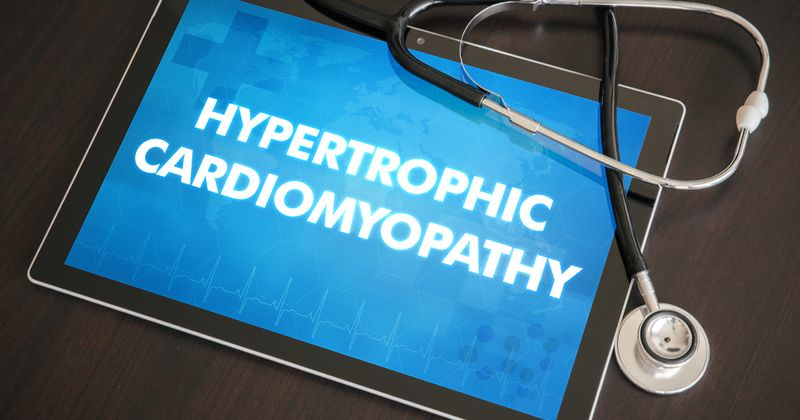Benefits of aficamten on obstructive HCM symptom burden, QoL sustained at 6 months
NATIONAL HARBOR, Md. — Aficamten was associated with sustained improvement in patient-reported symptom burden and quality of life at 6 months when used to treat obstructive hypertrophic cardiomyopathy, a speaker reported.
Treatment of obstructive hypertrophic cardiomyopathy (HCM) with aficamten (Cytokinetics), a novel selective cardiac myosin inhibitor, was associated with improvements across all domains of the Kansas City Cardiomyopathy Questionnaire (KCCQ) overall summary score, according to the results of the REDWOOD-HCM-OLE study presented at the Heart Failure Society of America Annual Scientific Meeting.

“Unlike the New York Heart Association classification, which is a way for physician providers to assess a patient’s feelings about how they’re doing, KCCQ score is a patient’s sense about what their physical limitations, social limitations, functional limitations and symptom burden are,” Sara Saberi, MD, assistant professor in the division of cardiovascular medicine and a member of the inherited cardiomyopathy program at the Samuel and Jean Frankel Cardiovascular Center at the University of Michigan Hospital in Ann Arbor, told Healio. “Patients who were participating in [REDWOOD-HCM-OLE] had already completed the parent study and were rolled over into this open-label trial. What we found was that those who had completed both a 12-week and a 24-week visit and had KCCQ data had experienced a significant improvement in every functional domain of the KCCQ as compared with baseline when treated with aficamten.”
In the phase 2 REDWOOD-HCM trial, researchers assigned 41 patients (mean age, 57 years; 60% women) with symptomatic HCM, left ventricular ejection fraction 60% or more and resting LV outflow tract gradient 50 mm Hg or more to aficamten 5 mg followed by 10 mg followed by 15 mg; aficamten 10 mg followed by 20 mg followed by 30 mg; or placebo.
The results of the phase 2 REDWOOD-HCM trial were presented at the HFSA Annual Scientific Meeting in September 2021.
As Healio previously reported, aficamten improved HF symptoms and hemodynamics at 10 weeks; conferred no serious treatment-related adverse events; and was not linked to excess incidence of adverse events compared with placebo in patients with obstructive HCM.
Based on these findings, the FDA granted breakthrough therapy designation for aficamten for the treatment of symptomatic obstructive HCM in December 2021.
For the present study, researchers evaluated patient-reported health status among participants in REDWOOD-HCM using the KCCQ score and compared baseline values with values collected at weeks 12 and 24.
At both 12 and 24 weeks, researchers observed significant patient-reported improvement across all domains of the KCCQ overall summary score including the clinical summary score, total symptom score, physical function score, social score and quality of life (QoL) score (P for all < .05). Patient-reported improvements in KCCQ scores were sustained for at least 6 months.
Improvement of at least five KCCQ points was observed in between 62% and 72% of participants across all domains of the overall KCCQ summary score.
Approximately 62% of participants had an improvement of one NYHA class by week 24 and no patients had a lower NYHA class compared with baseline, according to the presentation.

“We certainly have data on the hemodynamic and strain effects of HCM on this patient population and how aficamten changes those. There is a pretty dramatic improvement in all of those outcomes as well,” Saberi told Healio. “Aficamten very quickly, within a 4-week period of time, reduces the degree and severity of resting and dynamic outflow obstruction without markedly reducing ejection fraction by any means. It significantly improves markers of myocardial strain. [N-terminal pro-B-type natriuretic peptide] and cardiac troponin were also significantly reduced at the same time points, week 12 and week 24.”
The researchers also noted improvements in LV outflow tract obstruction (P < .0001), a 70% reduction in NT-proBNP level (P < .0001) and a 30% reduction in high-sensitivity troponin I (P < .005) at weeks 12 and 24 relative to baseline.
“Your high-sensitivity troponin or NT-proBNP may be elevated, but a blood marker doesn’t give you any sense about someone’s daily experience with their disease processes,” Saberi told Healio. “This analysis was focused on the patient’s day-to-day experience living their life with HCM and how aficamten shifted that day-to-day experience from the time that they enrolled in the study to these time points.
“We can reduce numbers on a graph and reduce the degree of outflow obstruction or the degree of strain on the heart. The person who’s living this day-to-day experience with the disease, yes, cares about those things, but the burden of how that affects their day-to-day life is really reflected in the KCCQ data,” Saberi said. “The fact that this drug is capable of making such a significant impact in the day-to-day experience of somebody living with this disease is really profound and impressive.”


